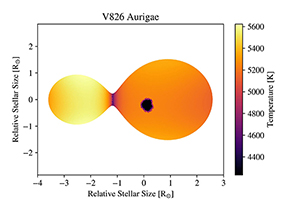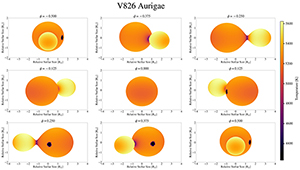Stellar family research reveals new details for constellation Auriga
V826 Aurigae is not exactly a household name. It refers to a celestial object in the constellation Auriga, also known as the Charioteer.
It is close to Capella, the brightest star in the constellation, and is above the horizon in the northern sky for most of the year. People are not able to see V826 Aurigae with the naked eye, and even with a telescope it only appears to be small speck of light.
Indiana University East Assistant Professor of Physics Wes Tobin studies this object more closely, using data obtained through collaboration with Ball State University.
“Compared to the Sun, V826 Aurigae is a strange object,” Tobin said. “Indeed, it is not a single star, but actually consists of two stars that, in a cosmic dance, closely orbit one another. They revolve around each other, circling the common center of gravity,” Tobin said.
As a result, one of the stars in the pair periodically eclipses the other, which leads to a gradual dimming and brightening of the light intensity of V826 Aurigae.
Even more surprising is that the two stars in the pair have different masses, proportional to the mass difference between a soccer ball and a baseball, or an adult to an 8-year-old child. The unequal twins have different diameters too, with the larger one being almost twice the diameter of the smaller one.
“Moreover, the stars have different surface temperatures with a 400°F difference,” Tobin said. “The distance between them is so small that the stellar surfaces touch each other and allow stellar material to flow back and forth between them. This appears very much as if the pair are in a warm embrace.”

Tobin’s observations and analysis revealed some interesting new facts about this binary system: He estimated the mass proportion, the inclination of their orbit, their temperatures, and even the magnitude of the embrace, which is called the fill-out factor.
“We were also able to determine where on the stellar surface a cool spot, like a sunspot, is likely to be found,” Tobin said.
Most stars are not single stars, such as the Sun, but are found in stellar families with one or more companion stars.
The study of these stellar families allows researchers to refine stellar evolution models and better understand star spots.
The results of Tobin’s research will be published in the journal New Astronomy, Volume 101. He co-wrote the paper titled, “Photometric study of the overcontact binary V826 Aur,” with Robert C. Berrington, associate professor of physics and astronomy at Ball State University. The paper will be published in July 2023. It is available to read now with a subscription.
In conducting this research, Tobin used extensive computer modeling through IU’s High-Performance Computing cluster to evaluate the properties of the stars.
Markus Pomper, dean of the School of Natural Science and Mathematics, said faculty research ultimately enhances the learning experience for students.
“We are a regional campus, but we have the support of the entire IU system,” Pomper said. “This allows our physics faculty to make meaningful contributions to a field like astronomy, where one would ordinarily need expensive, dedicated equipment.”
Having a stellar astronomer on the faculty allows IU East to offer classes that are taught by experts in their field.
“Tobin’s astronomy classes are very popular among students,” Pomper said. “We teach these classes online in order to allow students from all over the region to learn from an expert in the field.”



